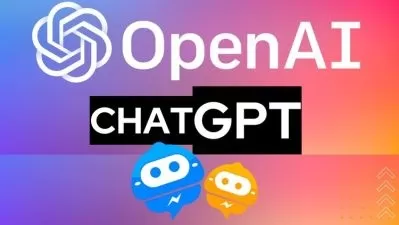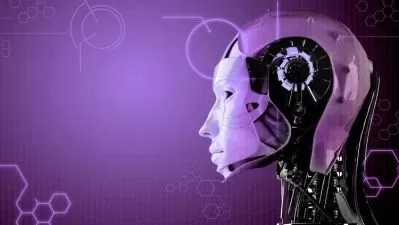Comprehensive Guide to Artificial Intelligence(AI) for All
Junaid Ahmed
11:19:46
Description
Learn ML, NLP, Deep, Transfer and Reinforcement learning with IBM Watson, Tensorflow Sim, Keras, OpenAI Gym and more
What You'll Learn?
- Clearly define what is AI and Deep Learning
- Build Convolutional Neural Network on IBM Watson for MNIST and CIFAR 10 Datasets (No coding)
- Build Supervised and Unsupervised Machine learning Models using IBM Watson (No coding)
- Test Natural Language Processing (NLP) models using IBM Watson
- Build VGG like nets, Stateful RNN nets, reuse ResNet50 using Keras
- Test Reinforcement Learning with Keras and OpenAI Gym
- Test Recurrent Neural Network (RNN) on Mathworks
- Learn to code with Python the easy way
- Test Feed Forward Neural Networks(Classification and Regression) on Tensor Flow simulator and Google Colab
- Solve popular data sets like MNIST, CIFAR 10, with CNN using Keras
- Learn a few useful and important application of popular libraries like Numpy, Pandas, Matplotlib
- Migrate Deep Neural Network models from IBM Watson to run on local your Jupyter notebook
- Apply Transfer Learning techniques such as Reusing, Retraining with keras
- Be able to identify the positive and the negative impact that AI will create
Who is this for?
What You Need to Know?
More details
DescriptionIf I can tell you, stop what ever you are doing and do a certain thing. I would say "Learn about AI and the impact it is going to have in your professional life, personal life and much more in the immediate future".
Welcome to this exciting and eye opening course on Artificial Intelligence and more. We believe that AI will touch everybody in some level, whether you are a technical or a non technical person and also that you can excel in many roles in AI with just a functional understanding of coding.
The course has over 11 hours of content with 100+ easy to consume, high quality, visually engaging, condensed and edited videos, over 10 Quizzes to check your understanding, reference material and code for further study.Â
This course has 3 parts, first we will start from the basics , break myths, clarify your understanding as to what is this mysterious term AI, (many are surprised to know that it encompasses, Machine Learning, NLP,Computer Vision, IOT, Robotics and more). We will also understand the current state of AI and its positive and negative impact in the near future.
Then we will apply the concepts we learnt with zero to little coding Involved.
- Machine learning (Supervised and Unsupervised)Â with IBM Watson
- Natural Language Processing (NLP) with IBM Watson
- Feed Forward Neural Networks (FFNN) with Tensor Flow Simulator
- Convolutional Neural Networks with (CNN) with IBM Watson
-Â Recurrent Neural Networks (RNN) with Mathworks
Smack in the middle we have easy and intuitive primer sections on how to code using Python, and also how to use popular libraries like Numpy, Pandas, Matplotlib all on the awesome browser based coding platform Jupyter notebook. These middle sections will prepare you for the next sections.
The final set of sections we will take a deeper dive in testing real life use cases and AI applications with Keras, Keras-Reinforcement, OpenAI Gym and more. The focus will be on building the student's confidence in understanding the data and building solutions. In the final sections you will see a bit more of code but the best part would be that by the end of the sections you will be running AI solutions powered by Deep Neural Networks on a browser with Jupyter Notebook on your Laptop !
- Solving popular data sets like MNIST, CIFAR 10, with CNN, Keras and Jupyter notebook running on your laptop
- Building VGGÂ like nets and Stateful RNN nets using Keras
- Migrating Neural networks from IBM Watson to run on local your Jupyter notebook
- Applying Transfer Learning technique such as Reusing, Retraining with keras
-Â Testing Reinforcement Learning with Keras and OpenAI Gym
The essence of the later sections will be to understand that there are so many libraries and resources available to you, and that it has been made easy for everyone. You just have to identify what you need to be done and look in the right direction.
AI brings tremendous opportunity like higher economic growth, productivity and prosperity but the picture is not all rosy. lets look at some data points from the renowned Mckinsey&Company.
" 250 million new jobs are likely to be created by 2030"*
" In the midpoint adoption scenario 400 million Jobs are likely to be lost by 2030"*
" In the midpoint adoption scenario 75 million will need change occupational categories by 2030"*
AI is the top priority for Companies, governments and institutions alike. AI surpasses a certain product, or vertical, or function, or a specific industry , it encompasses everything. It is all prevalent.
Based on the report there will be considerable shortages in the IT sector and companies are looking to fill these gaps by retraining, hiring, redeploying, contracting and even hiring from non traditional sources. Technological skill is the TOP skill that will be required during this time and by one research they will need 250,000 data scientists by 2030. If you develop these skills and knowledge , you can take advantage of this revolution irrespective of your role, company or Industry you belong to.
So if you are "AIÂ ready then you are future ready"
AIÂ is here to stay and the ones who get on board fast and adapt to it will be in a much better position to face the exciting but uncertain future.
Choose Success , make yourself invaluable and irreplaceable. I will see "YOU" on the inside.
God Speed.
Who this course is for:
- Folks who are curious about AI and want to learn it, in the fastest, easiest and the most effective way
If I can tell you, stop what ever you are doing and do a certain thing. I would say "Learn about AI and the impact it is going to have in your professional life, personal life and much more in the immediate future".
Welcome to this exciting and eye opening course on Artificial Intelligence and more. We believe that AI will touch everybody in some level, whether you are a technical or a non technical person and also that you can excel in many roles in AI with just a functional understanding of coding.
The course has over 11 hours of content with 100+ easy to consume, high quality, visually engaging, condensed and edited videos, over 10 Quizzes to check your understanding, reference material and code for further study.Â
This course has 3 parts, first we will start from the basics , break myths, clarify your understanding as to what is this mysterious term AI, (many are surprised to know that it encompasses, Machine Learning, NLP,Computer Vision, IOT, Robotics and more). We will also understand the current state of AI and its positive and negative impact in the near future.
Then we will apply the concepts we learnt with zero to little coding Involved.
- Machine learning (Supervised and Unsupervised)Â with IBM Watson
- Natural Language Processing (NLP) with IBM Watson
- Feed Forward Neural Networks (FFNN) with Tensor Flow Simulator
- Convolutional Neural Networks with (CNN) with IBM Watson
-Â Recurrent Neural Networks (RNN) with Mathworks
Smack in the middle we have easy and intuitive primer sections on how to code using Python, and also how to use popular libraries like Numpy, Pandas, Matplotlib all on the awesome browser based coding platform Jupyter notebook. These middle sections will prepare you for the next sections.
The final set of sections we will take a deeper dive in testing real life use cases and AI applications with Keras, Keras-Reinforcement, OpenAI Gym and more. The focus will be on building the student's confidence in understanding the data and building solutions. In the final sections you will see a bit more of code but the best part would be that by the end of the sections you will be running AI solutions powered by Deep Neural Networks on a browser with Jupyter Notebook on your Laptop !
- Solving popular data sets like MNIST, CIFAR 10, with CNN, Keras and Jupyter notebook running on your laptop
- Building VGGÂ like nets and Stateful RNN nets using Keras
- Migrating Neural networks from IBM Watson to run on local your Jupyter notebook
- Applying Transfer Learning technique such as Reusing, Retraining with keras
-Â Testing Reinforcement Learning with Keras and OpenAI Gym
The essence of the later sections will be to understand that there are so many libraries and resources available to you, and that it has been made easy for everyone. You just have to identify what you need to be done and look in the right direction.
AI brings tremendous opportunity like higher economic growth, productivity and prosperity but the picture is not all rosy. lets look at some data points from the renowned Mckinsey&Company.
" 250 million new jobs are likely to be created by 2030"*
" In the midpoint adoption scenario 400 million Jobs are likely to be lost by 2030"*
" In the midpoint adoption scenario 75 million will need change occupational categories by 2030"*
AI is the top priority for Companies, governments and institutions alike. AI surpasses a certain product, or vertical, or function, or a specific industry , it encompasses everything. It is all prevalent.
Based on the report there will be considerable shortages in the IT sector and companies are looking to fill these gaps by retraining, hiring, redeploying, contracting and even hiring from non traditional sources. Technological skill is the TOP skill that will be required during this time and by one research they will need 250,000 data scientists by 2030. If you develop these skills and knowledge , you can take advantage of this revolution irrespective of your role, company or Industry you belong to.
So if you are "AIÂ ready then you are future ready"
AIÂ is here to stay and the ones who get on board fast and adapt to it will be in a much better position to face the exciting but uncertain future.
Choose Success , make yourself invaluable and irreplaceable. I will see "YOU" on the inside.
God Speed.
Who this course is for:
- Folks who are curious about AI and want to learn it, in the fastest, easiest and the most effective way
User Reviews
Rating
Junaid Ahmed
Instructor's Courses
Udemy
View courses Udemy- language english
- Training sessions 104
- duration 11:19:46
- Release Date 2024/03/22











